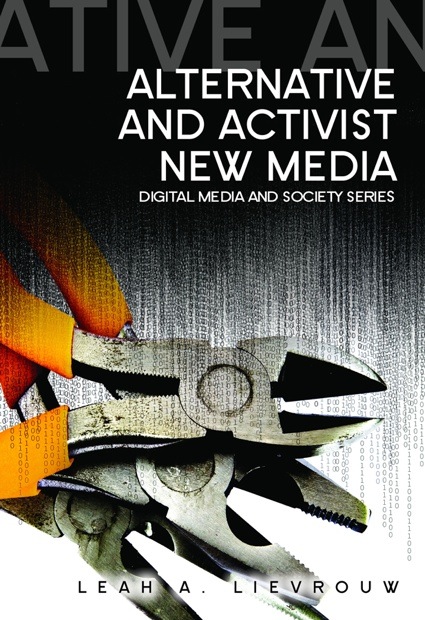Alternative and Activist New Media, by Leah Lievrouw.
Available on Amazon USAand UK.

Publisher Politi writes: Alternative and Activist New Media provides a rich and accessible overview of the ways in which activists, artists, and citizen groups around the world use new media and information technologies to gain visibility and voice, present alternative or marginal views, share their own DIY information systems and content, and otherwise resist, talk back to, or confront dominant media culture. Today, a lively and contentious cycle of capture, cooptation, and subversion of information, content, and system design marks the relationship between the mainstream ‘center’ and the interactive, participatory ‘edges’ of media culture.
Five principal forms of alternative and activist new media projects are introduced, including the characteristics that make them different from more conventional media forms and content. The book traces the historical roots of these projects in alternative media, social movements, and activist art, including analyses of key case studies and links to relevant electronic resources. Alternative and Activist New Media will be a useful addition to any course on new media and society, and essential for readers interested in new media activism.
®TMark, The Barbie Liberation Organization, 1993
I might have covered many books and exhibitions that demonstrate how artists use technology to protest, campaign, challenge institutions, or express social and political concerns but i still had to review a book that studied alternative and activist new media from an ‘Information Studies’ or purely social point of view. This one was written by a professor in the Department of Information Studies at the University of California, Los Angeles and it has the (rare) merit of including contemporary art practices in its field of investigation.
Leah Lievrouw looks at what she calls the five basic genres of contemporary alternative and activist new media: Culture Jamming (think of the Billboard Liberation Front or ®TMark), Alternative Computing (hacking), Participatory Journalism (e.g. Indymedia, blogs), Mediated Mobilization (the Arab Spring) and Commons Knowledge (Wikipedia). She goes from defining elementary concepts (such as “what makes new media ‘new'”) to detailing recent theories and observations in a seamless and impeccable way.
She describes Alternative and Activist New Media, traces back their antecedents, weights their strengths and weaknesses in, pits them against their mainstream/institutionalized equivalent, analyzes their rise from fringe to (almost) mainstream, sums up the debates surrounding this ‘new media ecology’, and illustrates each ‘genre’ with a case study.
Alternative and Activist New Media is a book for students. Of media, new media, communication, sociology, media art. This is also a book for people like you and me. People who’ve been using wikipedia for years, who blog, who know about The Yes Men’s “identity correction” performances. People who are familiar with the language and concepts of Alternative and Activist New Media. But does that mean that our insight doesn’t need more structure and a solid historical background?
Elvis, my young Staffie, was a equally enthusiastic about the book (or maybe equally unimpressed by the design of its cover) ….

Image on the homepage: The Yes Men’s golden skeleton.
